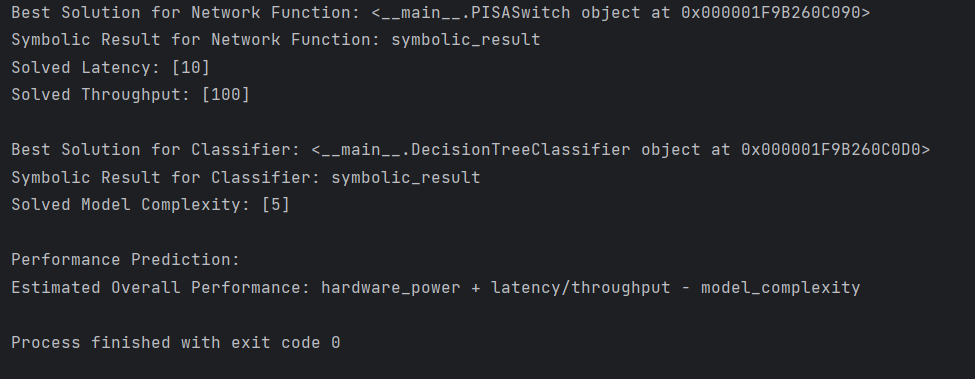(Solved): Convert this code into C++, provide the full execution of each function and library so that final co ...
Convert this code into C++, provide the full execution of each function and library so that final code given by you gives the same output as python code is giving. The output which i got from python code is -
Python code -
from abc import ABC, abstractmethod
import random
from sympy import symbols, Eq, solve
# Step 1: Define Abstract Components (Interfaces)
class NetworkFunction(ABC):
@abstractmethod
def process_packet(self, packet):
pass
@abstractmethod
def get_performance_metrics(self):
pass
@abstractmethod
def get_implementations(self):
pass
class Classifier(ABC):
@abstractmethod
def classify(self, data):
pass
@abstractmethod
def get_model_details(self):
pass
@abstractmethod
def get_implementations(self):
pass
# Step 2: Implement Multiple Backing Implementations
class PISASwitch(NetworkFunction):
def process_packet(self, packet):
# Symbolic execution for PISA switch
symbolic_result = symbols('symbolic_result')
return symbolic_result
def get_performance_metrics(self):
# Symbolic execution for performance metrics
latency = symbols('latency')
throughput = symbols('throughput')
return {'Latency': latency, 'Throughput': throughput}
def get_implementations(self):
return [PISASwitch]
class X86CPU(NetworkFunction):
def process_packet(self, packet):
# Symbolic execution for x86 CPU
symbolic_result = symbols('symbolic_result')
return symbolic_result
def get_performance_metrics(self):
# Symbolic execution for performance metrics
latency = symbols('latency')
throughput = symbols('throughput')
return {'Latency': latency, 'Throughput': throughput}
def get_implementations(self):
return [X86CPU]
class DecisionTreeClassifier(Classifier):
def classify(self, data):
# Symbolic execution for decision tree classifier
symbolic_result = symbols('symbolic_result')
return symbolic_result
def get_model_details(self):
# Symbolic execution for model details
model_complexity = symbols('model_complexity')
return {'Model Complexity': model_complexity}
def get_implementations(self):
return [DecisionTreeClassifier]
class NeuralNetworkClassifier(Classifier):
def classify(self, data):
# Symbolic execution for neural network classifier
symbolic_result = symbols('symbolic_result')
return symbolic_result
def get_model_details(self):
# Symbolic execution for model details
model_complexity = symbols('model_complexity')
return {'Model Complexity': model_complexity}
def get_implementations(self):
return [NeuralNetworkClassifier]
# Step 3: Search Process
class SynthesisSearch:
def __init__(self, components):
self.components = components
def search(self):
best_solution = None
best_score = float('-inf')
for _ in range(10): # Number of iterations for the sake of example
solution = self.generate_random_solution()
score = self.evaluate_solution(solution)
if score > best_score:
best_solution = solution
best_score = score
return best_solution
def generate_random_solution(self):
solution = {}
for component in self.components:
implementation = random.choice(component.get_implementations())
solution[component] = implementation
return solution
def evaluate_solution(self, solution):
# Simulate an evaluation process and return a score
# This could involve performance metrics based on your objectives
return random.randint(1, 100)
# Step 4: Simulator
class NetworkSimulator:
def simulate(self, network_function, packets):
for packet in packets:
network_function.process_packet(packet)
# Step 5: Performance Prediction Model
class PerformancePredictionModel:
def predict_performance(self, network_function, classifier):
# A simple model that combines different factors to predict performance
hardware_power = symbols('hardware_power')
model_complexity = symbols('model_complexity')
latency = symbols('latency')
throughput = symbols('throughput')
prediction = hardware_power - model_complexity + latency / throughput
return prediction
# Step 6: Example Usage
if __name__ == "__main__":
# Create instances of abstract components and their implementations
pisa_switch = PISASwitch()
x86_cpu = X86CPU()
decision_tree_classifier = DecisionTreeClassifier()
neural_network_classifier = NeuralNetworkClassifier()
# Step 6: Search for the best deployment
components = [pisa_switch, x86_cpu, decision_tree_classifier, neural_network_classifier]
search_process = SynthesisSearch(components)
best_solution = search_process.search()
# Step 7: Simulate and evaluate the best solution
best_network_function = best_solution[pisa_switch]()
best_classifier = best_solution[decision_tree_classifier]()
# Simulate packet processing
symbolic_result_nf = best_network_function.process_packet({'symbolic_data': 42}) # Provide an actual packet
# Simulate classification
symbolic_result_classifier = best_classifier.classify({'symbolic_data': 42}) # Provide an actual data for classification
# Symbolic execution for performance metrics and model details
performance_metrics_nf = best_network_function.get_performance_metrics()
model_details_classifier = best_classifier.get_model_details()
# Solve symbolic equations to obtain concrete values
solved_latency = solve(Eq(performance_metrics_nf['Latency'], 10)) # Replace 10 with an actual value
solved_throughput = solve(Eq(performance_metrics_nf['Throughput'], 100)) # Replace 100 with an actual value
solved_model_complexity = solve(Eq(model_details_classifier['Model Complexity'], 5)) # Replace 5 with an actual value
prediction_model = PerformancePredictionModel()
performance_prediction = prediction_model.predict_performance(best_network_function, best_classifier)
print("Best Solution for Network Function:", best_network_function)
print("Symbolic Result for Network Function:", symbolic_result_nf)
print("Solved Latency:", solved_latency)
print("Solved Throughput:", solved_throughput)
print("\nBest Solution for Classifier:", best_classifier)
print("Symbolic Result for Classifier:", symbolic_result_classifier)
print("Solved Model Complexity:", solved_model_complexity)
print("\nPerformance Prediction:")
print("Estimated Overall Performance:", performance_prediction)
